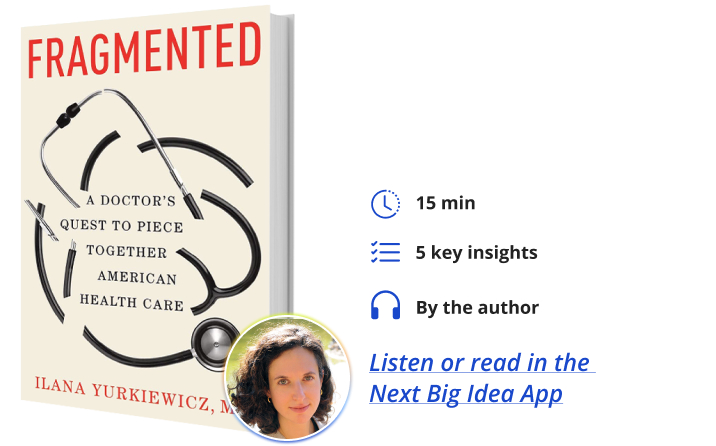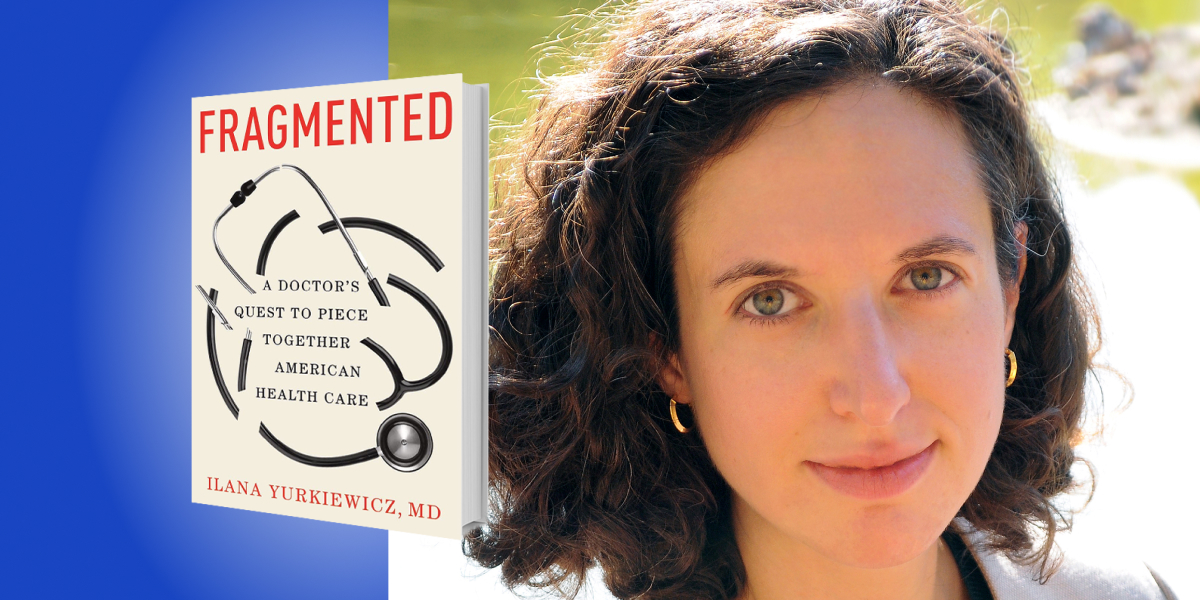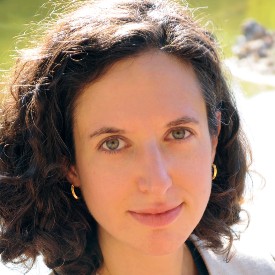Dr. Ilana Yurkiewicz is an oncologist and internal medicine physician on the faculty at Stanford Medicine. She is also a science and medical journalist whose work has been published in The Atlantic, Scientific American, Undark, The Best American Science And Nature Writing.
Below, Ilana shares 5 key insights from her new book, Fragmented: A Doctor’s Quest to Piece Together American Health Care. Listen to the audio version—read by Ilana herself—in the Next Big Idea App.

1. Your medical records don’t automatically transfer when you do.
As a first-year resident physician, I cared for an elderly veteran who was shuttled back and forth to my hospital three times, once in critical condition. This was all due to unshared records between my hospital and nursing facilities, letting vital details of his medical plan slip through the cracks. As his doctor, I did everything in my power to prevent this: I wrote up clear discharge summaries, bolded my notes, double-checked my medication lists, and even called the nursing facilities for a verbal handoff, but it wasn’t enough.
In 2009, Congress authorized and funded legislation known as HITECH, or the Health Information Technology for Economic and Clinical Health Act, to stimulate the conversion of paper medical records into electronic charts, and many hospitals and doctors’ offices did this successfully. However, there was no related push to require that these record-keeping systems communicated with one another. Today our healthcare record-keeping operates on hundreds of different electronic vendors and, as of 2021, only 55 percent of hospitals could find, send, receive, and integrate patient data from outside their facility.
For patients, in non-emergency situations, it’s somewhat of a medical-free market, meaning you have the choice to see a new doctor at your discretion. However, it means that your medical records often will not transfer when you do: between doctors’ offices, hospitals, nursing facilities, and sometimes even units within the same hospital system. Medical facilities use a patchwork of methods to track records, relying on proprietary technology or old-fashioned communications such as faxes and paper notes.
In the case of my elderly veteran patient, for example, my discharge notes were faxed to the nursing facilities, but they had no access to anything else, such as primary care notes or data from before his hospitalization. An initiative from the U.S. Department of Health and Human Services aims to unify these disparate systems, and in 2018, six big tech companies pledged their assistance as well. However, we remain far from a universal electronic medical record, something that would solve the problem.
2. Even within one healthcare system, electronic charts bury data.
The computerized charts we use as doctors are not merely electronic filing cabinets. In addition to storing records and data, they can also embed certain tools to help make sense of that information. For all the ways today’s computerized charts have the potential to connect large amounts of patient data seamlessly, there’s a catch: most of the time, they don’t. Even within one electronic vendor, charts are not written like a book, meaning they don’t organize patient data into meaningful narratives. Bloat without organization makes it hard for doctors to find the information we really need. At the same time, roundabout data entry forces healthcare workers to distract themselves with hours of extraneous computerized tasks.
“Doctors today spend two hours on computer tasks for every one hour facing patients.”
As a doctor, I spend hours after hours sleuthing through disorganized electronic charts. I once cared for a young man who had been hospitalized in my hospital nearly 100 times. When he came under my care, I dug and dug through his chart and couldn’t find a reasonable treatment plan in the time frame I had for the hundred-and-first episode of the same problem, forcing me to create it from scratch. The data mirrors my experiences: ordering something as simple as Tylenol requires providers to click between 14 and 62 times, with the confusion causing errors in up to 30 percent of cases. The number of clicks in one 10-hour shift in the emergency room is about 4,000. Nearly 60 percent of doctors’ notes are identical, and therefore redundant, to the previous ones.
This is not actually a problem of technology but is related to the unintended consequences of an initial design. When the great shift from paper charts to electronic ones began, the government wanted to stimulate the entire country to go paperless. In order to track which hospitals were adopting the new technology, the federal agency behind the operation set standards where a slew of metrics had to be met electronically for hospitals to receive funding. Because these metrics were fundamentally designed for billing rather than patient care, doctors were required to jump through clunky hoops to receive reimbursement. The electronic ecosystem became littered, and over time, we have only added to the garbage pile.
The result is that doctors today spend two hours on computer tasks for every one hour facing patients. Over half of primary care doctors believe the electronic charts make it easy to miss results, and 30 percent reported personally missing abnormal findings. Thanks to disorganized electronic charts, stitching a patient’s story together, even when all the data is there, is labor-intensive and error-prone.
3. Doctors aren’t interchangeable from one day to the next.
Most medicine isn’t one and done. While seeing patients over time, I can make changes, follow up on what worked, and focus on incremental improvements. Continuity between a doctor and the patients she knows leads to better care. But the truth is that factors as mundane as doctors’ schedules can make or break this crucial continuity.
One highly debated example involves shifts that last 28 consecutive hours—a rite of passage for many doctors. The arguments against these schedules typically focus on the very real effects of sleep deprivation on decision-making. Meanwhile, proponents have long defended these hours in the language of combatting fragmentation. At face value, their logic borders on the obvious: continuous hours lead to continuous medical care, as a doctor working many hours in a row can manage their patients’ stories without the gaps that would result from leaving and coming back. But the reality on the ground suggests the opposite is true: schedules that permit 28-hour shifts exacerbate fragmentation. The reason has to do with what happens when we trade continuity over days for continuity over hours.
When I worked 28-hour shifts in the intensive care unit, I was responsible for it all: keeping all the current patients alive, as well as accepting new patients. Highly complex, critically ill new patients would arrive at midnight, 2 AM, and 4 AM, each needing to be evaluated and stabilized whether I had been on the job for one hour or twenty-three. As the hours passed, I became focused on the highest-acuity breadcrumbs in front of me, creating a mentality of “I’m just covering until my shift is done.” As a new doctor took over the next day while I was home sleeping, the pattern repeated on a daily basis.
“As we rotated, we’d play catch up, start and stop medications, and miss larger trends.”
Our team of doctors became a revolving door; we each had authority for one day and one night and were gone the next. No one could take responsibility for the work not as immediately pressing, but just as crucial in the long run. Who reads the 400 pages of outside hospital records? Who calls the patient’s son who speaks a different language? As we rotated, we’d play catch up, start and stop medications, and miss larger trends.
Arguments in favor of 28-hour shifts operate on the faulty assumption that doctors are interchangeable from one day to the next. They ignore the value that comes from building relationships and the medical insights that develop from seeing the story play out every day. When doctors work 28 hours, we do the immediate work of reacting to medical complications but struggle with anything longer term. We lack both the context to see larger trends and the accountability to plan ahead.
4. Specialists can be thinking perfectly, but the whole can still fall apart.
Doctors spend many years training to reach their peak of expertise. For me, it was 14 years: four years of college, four years of medical school, three years of residency in internal medicine, and three years of fellowship in oncology and hematology. Physicians today can receive board certification to practice in over 135 specialties and subspecialties. In many swaths of medical culture, deeper sub-specialization is favored, leading to financial rewards and higher respect. Today, there is no way around it: caring for sick patients involves working in teams.
A strange thing can happen as each specialist takes reasonability for one thread of the patient’s overall story. Theoretically, someone should be reconciling these viewpoints and putting it all together, but the nature of teamwork can diffuse this responsibility. The whole can fall apart, even while each doctor perfectly manages their slice.
I once cared for a woman with leukemia, her most pressing issue was stubborn white patches in her lungs that caused her to gasp for air while I cranked up her oxygen support. Three teams of doctors were on the case. Each team, viewing her through the lens of their specialty, was logical. From an infectious diseases perspective, we were already treating the most probable infections. From a pulmonary, or lung, standpoint, she had undergone one bronchoscopy that didn’t reveal the diagnosis, so doing another would be unnecessary and risky. From a hematologic vantage point, there was no safe way to speed up recovery of her immune function that had been suppressed from chemotherapy. As my patient worsened, three reasonable narratives added up to a conclusion of staying the course, which didn’t feel reasonable yet. I decided to take a risk and treat my patient for things that were considered highly unlikely from each specialty angle.
“Caring for sick patients involves working in teams.”
Later, I realized that the most radical act I performed was not disagreeing with other doctors; it was suggesting that there was even a decision to be made. The radical act was looking beyond the specialist’s lens, each with a rational assessment in a vacuum but a suboptimal conclusion when taken together. The empowering fact is that anyone can do this. While generalists are trained to look for the big picture, specialists, patients, and loved ones can advocate for teams to communicate and look beyond narrow narratives for larger truths. But this mindset has to be intentional. The conveyor belt of subspecialized patient care, which splits patients into body parts and organ systems, often doesn’t create room to look for that bigger picture.
5. New payment models are needed for primary care doctors to safeguard the story.
As it stands, the burden of safekeeping the full story rests squarely with patients and families, as they are the only guaranteed continuity in their own care. In theory, the doctor equivalent with the most potential for doing this is the primary care physician. Current payment models force primary doctors to fragment patient care into discrete and infrequent transactions, even though they’re the most holistic specialty.
This is because most of medicine, 88 percent as of 2021, operates according to a payment model known as fee-for-service, where health organizations or doctors are paid based on discrete services they provide. In primary care, that service has been commodified into the office visit. Nothing else directly counts as paid work: not communicating with patients in between visits, not following up on abnormal test results, not sorting through medical records, and not communicating with specialists. The financial incentives are stacked to see as many patients face-to-face per day as possible and insurance companies reimburse more for new patients than follow-ups. This means that visits are compressed into fifteen minutes and a typical primary doctor’s panel swells to over 2,000 patients. The workload for doctors spills into the off hours, and as the good ones try to do it all anyway, they are burning out and quitting in droves, all while patients vie for coveted, hard-to-get slots.
I spent some time in a clinic with a different payment model, where insurance paid an upfront sum, equal to what they were already paying per patient, for whatever the patient needed to get healthier. This allowed the practice to cap with hundreds of patients instead of thousands, hire team members to help manage clerical tasks and provide the time for seamless continuity of care with regular phone calls and check-ins. While change to the payment model nationwide is slow, innovative clinics like this show it’s possible to restructure existing resources to create a medical world in which doctors know their patients and patients can access their doctors, allowing primary doctors to safeguard the patients’ full stories as intended.
To listen to the audio version read by author Ilana Yurkiewicz, download the Next Big Idea App today:





























